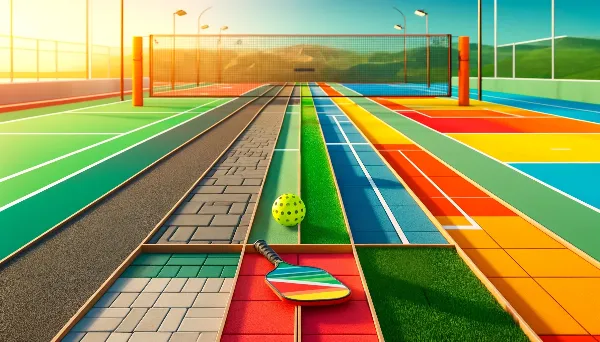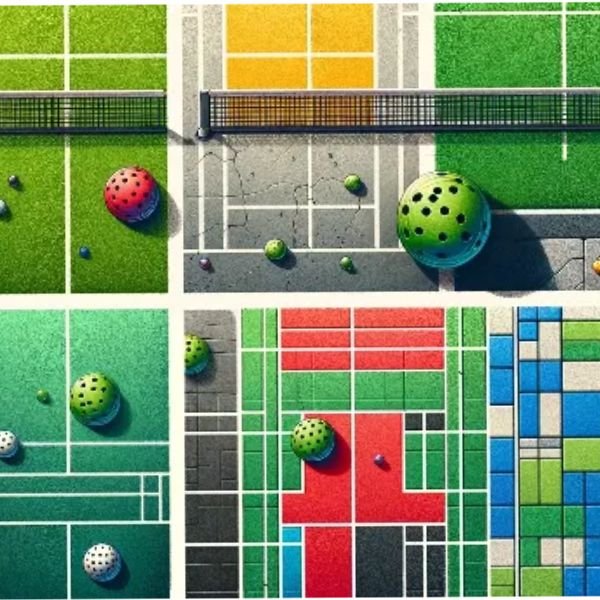One key aspect that can significantly impact your game is the pickleball surface. Choosing the right surface can enhance your play experience and even improve your shots by up to 5%. But what are the best options for a pickleball court surface, and why does it matter? Let’s dive into the details.
Table of contents
What Surface Can Pickleball Be Played On?
Pickleball can be played on a variety of surfaces, each offering different advantages and playing experiences. The main options include:
| Surface Type | Description | Pros | Cons |
|---|---|---|---|
| Concrete | Durable and widely used, provides consistent bounce. | Highly durable, consistent play. | Hard on joints over long periods. |
| Asphalt | Similar to concrete but slightly softer. | Durable, slightly softer than concrete. | Requires regular maintenance. |
| Clay | Gentle on joints, requires more maintenance. | Soft on joints, traditional feel. | High maintenance, inconsistent bounce. |
| Grass | Can be played on but not ideal for serious play. | Soft surface, easy on joints. | Uneven, unpredictable bounce. |
| Plastic/Rubber Tiles | Modular surfaces, easy to install, indoor and outdoor use. | Easy installation, good grip. | Can be expensive, may require replacement. |

How Much Space is Needed for a Pickleball Court?
A standard pickleball court is 20 feet wide and 44 feet long for both singles and doubles play. This size includes the playing area and the boundaries, ensuring players have enough room to move around and make their shots.
Best Surface for a Pickleball Court
When considering the best surface for a pickleball court, it’s essential to focus on durability, maintenance, and playability.
Surface Comparison Table
| Surface Type | Durability | Maintenance | Playability | Comfort for Joints |
|---|---|---|---|---|
| Concrete Pickleball Court | High | Low | Excellent | Low |
| Asphalt | High | Medium | Very Good | Medium |
| Clay | Medium | High | Good | High |
| Plastic/Rubber Tiles | Medium | Low | Very Good | High |
- Concrete Pickleball Court: Concrete is often considered the best surface for pickleball courts. It offers a consistent bounce and is highly durable. However, it can be hard on the joints over long play periods.
- Acrylic Paint for Pickleball Court: Applying acrylic paint can enhance the surface by providing better traction and reducing glare. This coating also helps in marking the court with proper pickleball court striping.
- Pickleball Court Coatings: Specialized coatings can be applied to concrete or asphalt surfaces to improve grip and cushion the impact, making play more comfortable.
What Kind of Base is Required for a Pickleball Court?
A solid, stable base like concrete or asphalt is ideal for a permanent court. These materials provide a durable and consistent playing surface, which is essential for maintaining the integrity of the game. They also offer excellent drainage, which helps prevent water accumulation and extends the court’s lifespan.
Can Pickleball Be Played on Grass?
Yes, pickleball can be played on grass, but it is not the best surface for serious play. Grass courts are often uneven, which can lead to unpredictable bounces and a slower game pace. However, grass is a soft surface that is easy on the joints, making it suitable for casual play and those who prefer a more forgiving surface.
To play pickleball on grass, ensure the lawn is well-maintained and as flat as possible. Temporary court lines can be set up using boundary markers or chalk.
Additional Considerations:
- How should pickleball courts be cleaned? Regular cleaning with a broom or leaf blower helps maintain the court surface.
- How often should pickleball courts be cleaned? Courts should be cleaned at least once a week to keep debris off the playing surface.
Practical Tips:
- Resurfacing: Regular resurfacing can extend the life of your court. For concrete and asphalt, resurfacing every 4-5 years can maintain optimal play conditions.
- Slope: Ensure your court has a slight slope for drainage, typically around 1-2%.
- Indoor Pickleball Court Surface: For indoor courts, consider plastic or rubber tiles that provide excellent grip and are easy to maintain.
- Pickleball Court Resurfacing Process: This involves cleaning the court, repairing any cracks, and applying a new surface coating. It’s best handled by professionals to ensure a high-quality finish.
Additional Considerations:
- What are the best color combinations for use on a pickleball court? Bright, contrasting colors like blue and green are popular for visibility.
- What kind of coating should be used to surface or paint pickleball courts? Acrylic-based coatings are commonly used for their durability and traction.
- What are the benefits of cushioned pickleball court surfaces? Cushioned surfaces reduce impact on joints, providing a more comfortable playing experience.
- Is there any difference between indoor and outdoor pickleball court surfaces? Yes, outdoor surfaces need to be more durable and weather-resistant, while indoor surfaces can focus more on comfort and traction.
- How can I fix the cracks on my pickleball court? Use a patching compound specifically designed for sports courts and follow up with a surface coating to prevent further damage.
Conclusion
Choosing the right pickleball surface is crucial for enhancing your play experience and maintaining your court’s longevity. While concrete remains the top choice due to its durability and consistent playability, other options like asphalt, clay, and modular tiles each have their unique benefits. Whether you’re setting up a permanent court or a temporary one, understanding these surfaces will help you make an informed decision.



